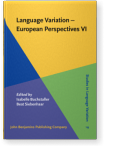Variation in Croatian
The verbal behaviour of rural speakers in an urban speech community
This paper’s objectives are to acquire general insight into the verbal behaviour (VB) of young speakers from the rural (island, coast, and hinterland) areas surrounding the Croatian coastal town of Zadar by examining the reported use of spoken and written codes as well as the social indexicalities of different varieties. The hypothesis is that, while socializing and communicating with speakers of urban varieties, speakers of less dominant (i.e. rural Čakavian or Neo-Štokavian) varieties tend to accommodate and converge linguistically as a consequence of their language attitudes and stereotypes. My research reveals that rural speakers generally accommodate, that island and coastal speakers accommodate more than hinterland speakers, and that women generally accommodate more than men.
Article outline
- 1.Introduction
- 2.Hypothesis and objectives
- 3.Method and problems of method
- 4.The controlled process of self-representation as an act of identity
- 5.Geographical markers as social markers
- 5.1The dynamics of rural speakers’ identity construction
- 5.2Differences in verbal behaviour based on the hinterland – island/coast duality
- 5.3Gender and perceived accommodation
- 6.Conclusions
-
Notes
-
References
References (21)
References
Chambers, J. K. and Trudgill, Peter. 1998. Dialectology. Cambridge: Cambridge University Press. 

Coupland, Nikolas. 2007. Style, Language Variation and Identity. Cambridge: Cambridge University Press. 

Edwards, John. 2009. Language and Identity: An Introduction. Cambridge: Cambridge University Press. 

Eckert, Penelope and Sally McConnell-Ginet. 2003. Language and Gender. Cambridge: Cambridge University Press. 

Eckert, Penelope. 2012. “Three Waves of Variation Study: The Emergence of Meaning in the Study of Sociolinguistic Variation”. Annual Review of Anthropology 41: 87–100. 

Filipić, Petar. 2012. Ekonomski paradoksi. Zagreb: Naklada Jesenski i Turk.
Goffman, Erving. 1959. The Presentation of Self in Everyday Life. New York: Doubleday.
Haeri, Niloofar. 1996. The Sociolinguistic Market of Cairo: Gender, Class and Education. London: Kegan Paul International.
Hoyt, D. Alexander. 2012. Hrvatski jezik u Zagrebu. Sociolingvistički pogled. Zagreb: Hrvatska sveučilišna naklada.
HR=Hrvatska enciklopedija Leksikografskog zavoda Miroslava Krleže. [URL] (Accessed 29/6/2016)
Hraste, Mate. 1964. “O govoru Zadra i okolice“. Zadar zbornik. 443–456.
Iannàccaro, Gabriele. 2011. “Patterns of Language Maintenance; A Quantitative Approach.” Language Contact and Language Decay, ed. by Miola, Emanuele and Paolo Ramat, 137–163 and 249–283. Pavia: IUSS Press.
Kapović, Mate. 2004. “Jezični utjecaj velikih gradova”. Rasprave instituta za hrvatski jezik i jezikoslovlje 30: 97–105.
Labov, William. 2001. Principles of Linguistic Change, Volume 2. Social Factors. Oxford: Blackwell.
Labov, William. 2010. Principles of Linguistic Change, Volume 3. Cognitive and Cultural Factors. Oxford: Blackwell. 

Le Page, Robert B. and Andrée Tabouret-Keller, 1985. Acts of Identity: Creole Based Approaches to Language and Ethnicity. Cambridge: Cambridge University Press.
Lisac, Josip. 1996. “Dijalekti zadarskoga kraja”. Marulić. Hrvatska književna revija 29: 521–526.
Marković, Irena. 2012. “Jezični utjecaji i promjene u suvremenom govoru Zadra“. Croatica et Slavica Iadertina: 313–335.
Myers-Scotton, Carol (ed). 1998. Codes and Consequences: Choosing Linguistic Varieties. Oxford: Oxford University Press.
Nichols, Patricia. 1978. “Dynamic Variation as a Model for the Study of Language and Sex”. Paper presented at Ninth World Congress of Sociology, Uppsala, Sweden.
Žanić, Ivo. 2009. Kako bi trebali govoriti hrvatski magarci? O sociolingvistici animiranih filmova. Zagreb: Algoritam.
Cited by (1)
Cited by one other publication
Huang, Li & James Lambert
2020.
Another arrow for the quiver: a new methodology for multilingual researchers.
Journal of Multilingual and Multicultural Development 41:7
► pp. 567 ff.

This list is based on CrossRef data as of 16 july 2024. Please note that it may not be complete. Sources presented here have been supplied by the respective publishers.
Any errors therein should be reported to them.
